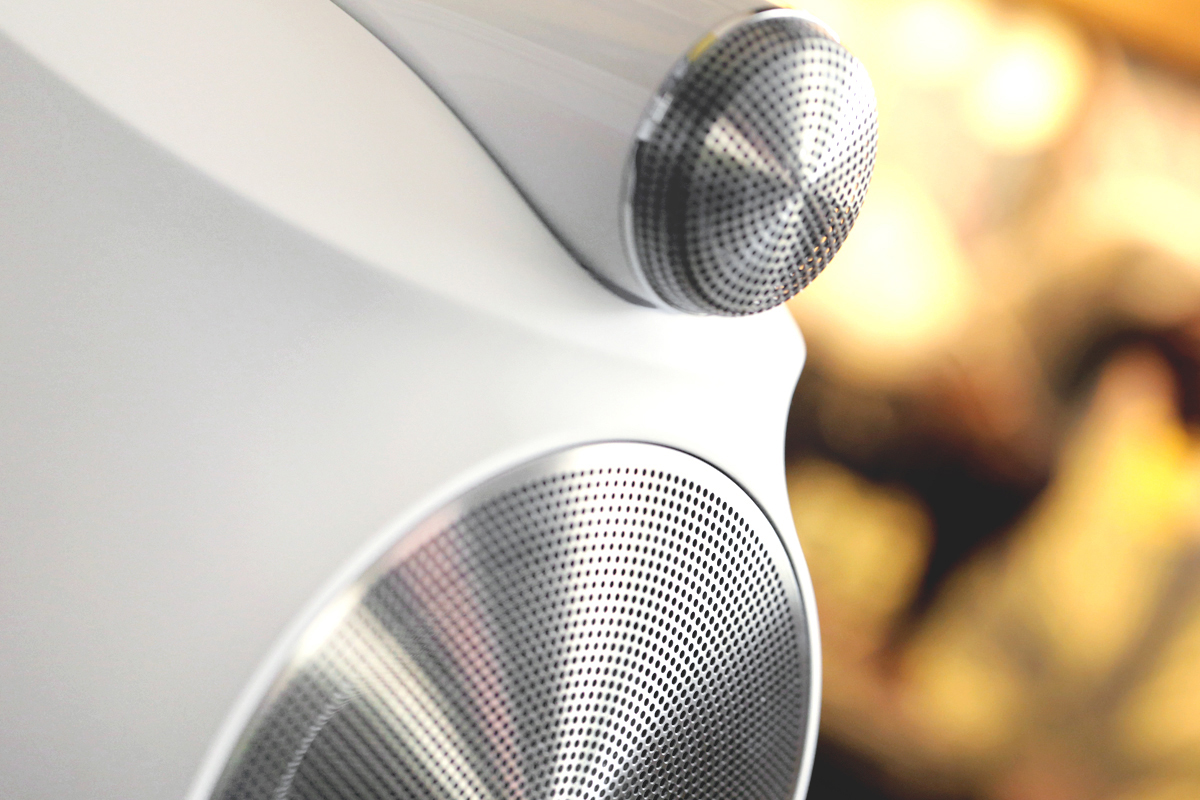The past five years have been mighty tumultuous for Bowers & Wilkins. In May 2016, the venerable British loudspeaker brand was acquired by EVA Automation Inc., a Silicon Valley startup. The two companies joined forces to develop a series of wireless audio products, which they unveiled in April 2019.
The Formation series included the Formation Bar soundbar ($1199, all prices USD); Formation Flex ($449) and Wedge ($899) all-in-one wireless speakers; Formation Bass subwoofer ($999); Formation Audio streamer ($699); and Formation Duo stereo wireless speakers ($3999/pair). When I reviewed the Formation Duo for Simplifi in July 2019, it received Reviewers’ Choice honors, and was subsequently named a 2019 SoundStage! Network Product of the Year.
The marriage between these unlikely partners didn’t last. By the late summer of 2020, EVA Automation was in severe financial distress, and one of its largest creditors was trying to force it into bankruptcy. In October 2020, EVA sold Bowers & Wilkins to Sound United LLC, parent company of Boston Acoustics, Classé, Definitive Technology, Denon, Marantz, and Polk Audio. EVA Automation ceased operations in November 2020.
Some critics maintained that EVA’s failure was caused by slow acceptance of the Formation series. According to an article on EVA’s cessation of business, “the series was not successful enough.” Another blamed EVA’s “degraded circumstances . . . on the failure of their Formation wireless speaker line marketed under the B&W brand.”
Did slower-than-expected sales of the Formation series lead to EVA’s failure? Since being sold to Sound United, Bowers & Wilkins has announced several new passive loudspeakers and headphones; but there have been no new Formation products. Sound United’s portfolio includes another wireless audio technology, HEOS, which is used on many Denon and Marantz products. Under its new ownership, will B&W continue to support and develop the Formation products?
To address these questions, I spoke with Andy Kerr, Director of Product Marketing and Communications for Bowers & Wilkins. “I think it would be fair to say that EVA Automation’s expectations—and those of its investors—were somewhat different from ours,” Kerr acknowledged. “Formation products only went on sale in April 2019. Our split with EVA Automation followed a year later. That’s not long enough for any new product, or category of product, to deliver a transformative sales breakthrough. It took some of the biggest brands in this space several years to really gain traction, Sonos being a prime example.”

B&W remains highly committed to Formation, Kerr added. “In the past year, we’ve worked hard to address early teething problems with our new platform, and also expand the range of services and features it offers.”
Our conversation took place on May 10 via a Microsoft Teams videoconference, with some follow-up questions being addressed through an e-mail exchange. The following interview has been edited for clarity and brevity.
Gordon Brockhouse: Let’s start at the beginning. What was the genesis of the Formation series? Did it start before EVA Automation acquired Bowers & Wilkins?
Andy Kerr: It started long before that, back in 2012. Working with my colleague Chris May [B&W’s senior director product strategy, product management, and user experience], we asked, what’s going to be the next generation of premium audio?
We’d done wireless players like Zeppelin Air, which works with Apple’s AirPlay platform. But we knew those platforms couldn’t scale. They couldn’t cope with high-resolution formats. They couldn’t scale to true separated stereo.
Think about the long-term growth model for the Bowers & Wilkins business. How do you convince younger buyers, who have grown up in an environment where music lives on a mobile device and goes to a single component, such as a Zeppelin Air, to take the next step on their audio journey: to move up to separated stereo? That will give them all the cool stuff we like to talk about: the soundstage, the image.
Asking younger consumers to do that, and then telling them they have to get cables and amps as well as speakers, will be really confusing to them. If we were going to do this, we had to find a way to make wireless stereo loudspeakers work properly. We evaluated a lot of the emerging wireless technologies. We weren’t looking so much at the resolution as the synchronization.
As you know, when you put a regular pair of passive loudspeakers in a room, a difference of a few inches in the distance of one speaker to the listener relative to the other can make a huge difference to the stereo image.
In our evaluation, we found that a lot of so-called “true stereo” wireless platforms weren’t stereo at all. What they gave was sound from two speakers. Some had delays of 2 or 3msec between the signal coming from the left and the right. Acoustically, this translates to inches of difference in terms of how the speakers are positioned in the room, which meant it was really hard to get a nice stereo image.
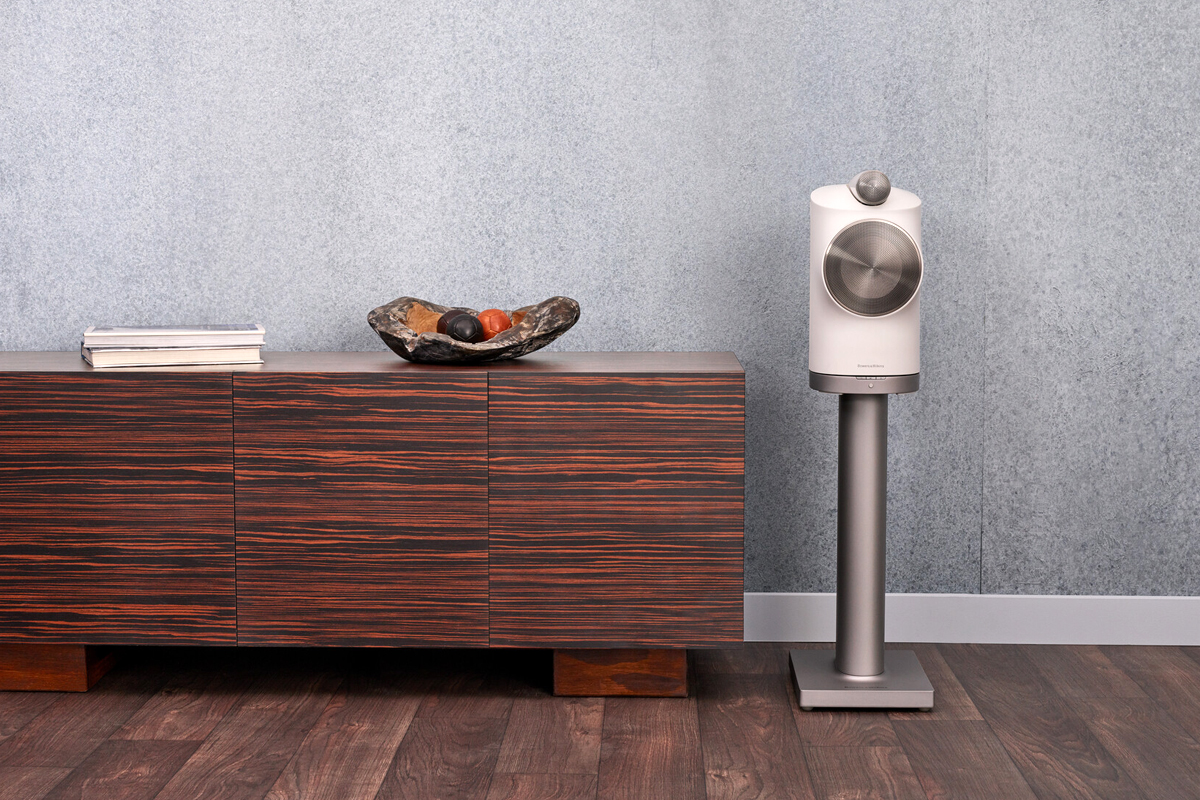
Also, a lot of these platforms were beaconing—one speaker was always trying to reacquire the other. So the sounds from the two speakers were constantly moving backward and forward relative to each other. That’s like the soundstage going for a big wander.
In the end, we concluded that we needed to develop our own wireless platform. We felt we could achieve time alignment and synchronization that we couldn’t get from other platforms. So, we began looking for technology partners.
During that process, we came across EVA Automation. At that time, they were working on ways of distributing high-resolution video to multiple locations. If you can move 24- or 30-frame-per-second video in resolutions up to 1080p with no loss in quality and good synchronization, so that multiple rooms can play simultaneously with no dropped frames, then audio is a walk in the park.
So, when they approached us, we were very interested. At that point, they were interested in us providing an audio endpoint that would go on the back of their video system. Eventually, it got to a point where everyone said we should merge, which is what happened.
GB: At this point, how close was Bowers & Wilkins to developing a wireless platform? Had you merely identified the problem, or had you made real progress in addressing it?
AK: We hadn’t made real progress in coming up with our own solution. We had evaluated all the available platforms. After very thorough analysis, we had concluded that some were better than others—but we wanted to do better if we could. We wanted latency in the microseconds—which is where we ended up.
The more revealing a speaker is, the more accurate the transducer, the more these problems become apparent. We wanted a system that we could put on the end of an 800-series speaker—the best speaker we know how to make. That’s the reason the first Formation product—the Formation Duo—was so obviously designed as a Bowers & Wilkins loudspeaker. We were making a point that this technology works.
GB: Was latency the biggest challenge you faced with Formation?
AK: That and stability. We wanted to make the system as robust and repeatable as a cabled system. That’s why there are six antennas and multiple radios inside each product. We wanted a product that people who had owned a Zeppelin could step up to. But equally, we wanted a system that people who had used our 600-series passive speakers could move to, and not feel that they’d been short-changed.
GB: Was EVA responsible for the networking and wireless portion of Formation, while Bowers & Wilkins developed the acoustics portion?
AK: EVA had people who know how the wireless stuff works, but making it work inside an active loudspeaker was a joint exercise. If you have everything inside the speaker, including the antenna, there are range and stability concerns. We needed to find ways of making cabinets and antennas that would get past those problems.
At the simplest level, you have a big magnet inside the speaker. Early wireless speakers had an antenna sticking out the back. Companies had to do that because their speakers were kind of like a Faraday cage. There’s a lot of metal inside.
MDF, which is used in a ton of speakers, including some of ours, isn’t a good conductive material for RF signals, so we use a different material for the Formation enclosures. We also had to recruit more DSP programmers. And we had to figure out how to miniaturize certain components.
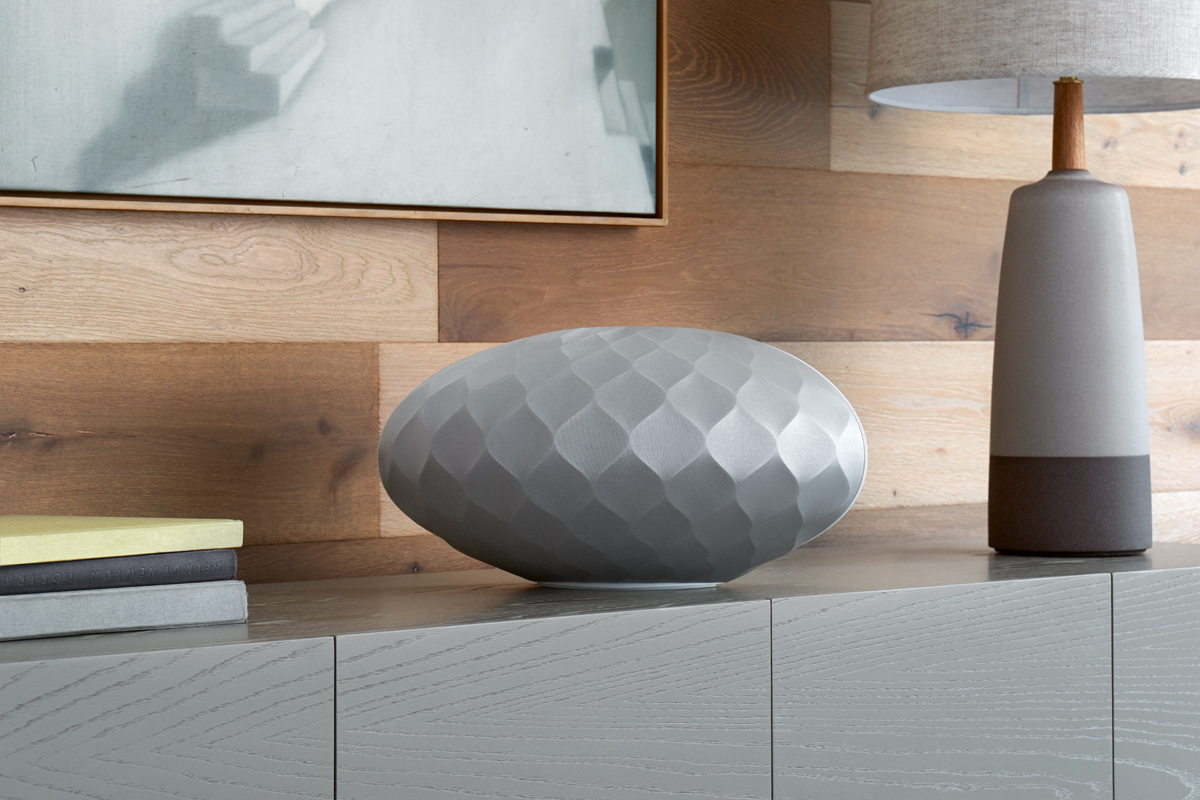
GB: How important is it for companies like Bowers & Wilkins, and the audio industry at large, to be moving in this direction?
AK: It’s hugely important to move with the times. You have to recognize that when the iPod and iTunes emerged in 2001, it changed everything about how music is consumed. That little device drove ten years of expansion. You can also argue that it drove ten years of compromised audio quality, and I understand that fully.
Now we have a full generation that has grown up without using physical media to play music. If you want to be relevant to that audience, you have to offer something they can understand.
We wanted to do so in a way that didn’t compromise the values of our brand. We wanted Formation to complement our existing portfolio, rather than conflicting with it. That’s why we didn’t take the wireless stuff and stick it in the back of a 600-series loudspeaker.
But I want to be clear: this does not mean we’re going to stop making passive loudspeakers. As long as there are customers who want those products, we’ll carry on making them.
GB: To what degree do the sales channels for Formation and traditional Bowers & Wilkins products overlap?
AK: We are still trying to encourage the dealer demo experience. You can’t fully appreciate what a difference sound quality makes without hearing it yourself.
We do make certain Formation products available direct and online. But it is interesting how well the larger items, especially the Duo, have been embraced by our regular dealer base. It’s a proper loudspeaker, but it’s just one that’s kind of turnkey.
It also opens up some installation choices. The obvious one is customers who want to put the speakers on either side of a fireplace or full-length window. How do you do that? With Duo, there’s no problem, and you’re still not compromising on the sound quality.
GB: Are there models that have done better than you expected?
AK: Undoubtedly, the Duo. It’s one of the most premium-priced wireless stereo speakers out there. It’s been embraced.
A passive loudspeaker system can sound astonishing. But from an engineering perspective, it throws up a lot of variables that we can’t control. You could partner the speakers with the right kind of amplifier, but you could also partner them with a completely inappropriate amplifier, and we can’t control that. You could wire it out-of-phase, and we can’t control that.
With an active system, we’re defining everything. It’s a self-contained package. We can optimize the amplifier to each drive unit. We know exactly what the signal path is. With DSP, we have full control over how the drive units behave.
The Duo is a non-ported system because system electronic circuitry and moisture don’t get along well. The woofer has double-stacked magnets. We can use the DSP to make the cone move a ton more than in an equivalent 705 or 805 passive speaker, because we’ve got really powerful control with two magnets. The cone still won’t pop out. So the Duo goes down phenomenally low. For a two-way loudspeaker, the output is just insane.
It doesn’t mean that it’s better than a passive system. Get things right with a harmonized amp, cabling, and speakers, and you can make a stellar system. But an active system like the Duo is very repeatable. For a certain kind of customer, and a certain kind of retailer, that’s a really appealing solution. You can take them out of the box, put them on their stands, and they’re going to sound the way they should sound.
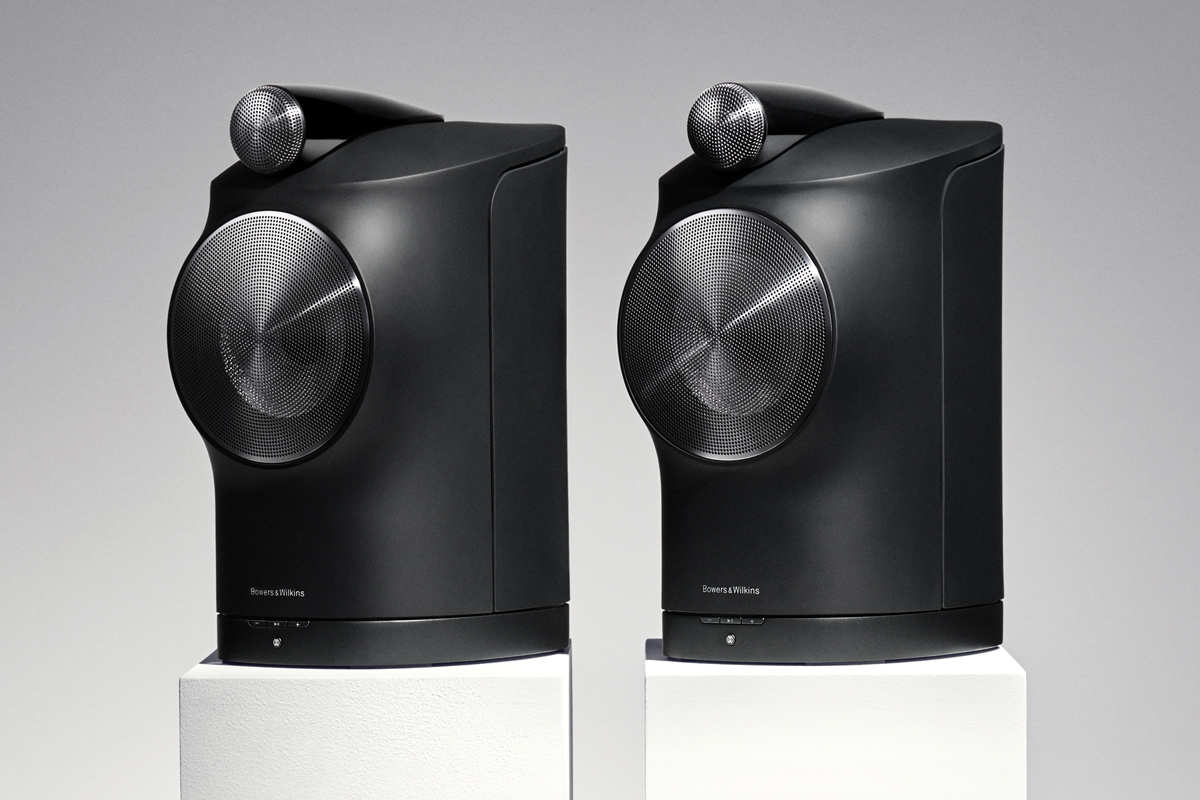
GB: How are you using DSP in the Formation Duo?
AK: There are two 40-bit accumulators in there, so you get incredibly precise calculations. At any given frequency, we can optimize the behavior of the cone, so we can make sure that as you go down in frequency and up in volume, you’re getting the maximum excursion without the risk of over-driving the amplifier or inverting the suspension. Whether you’re playing Rachmaninoff or Rage Against the Machine, you’re going to get the most you can possibly get out of the speaker, with no risk of damage.
The crossover is fully digital. We achieve a microscopic level of precision. You get phenomenal integration between the two drivers, especially in the top end of the midrange.
We didn’t put in room EQ, but there is dynamic EQ. In most small systems, as you play louder, the low-frequency output tends to flatten. Dynamic EQ preserves the character of the sound when the system gets louder. You get that nice full sound you get at lower volume levels. For later generations, one of the things we’re looking at is how to use DSP to deal with the room.
GB: Some of your competitors already have wireless speakers with room EQ. Is this something that could be retrofitted into current Formation products through a firmware update?
AK: The products have multiple microphones, which will allow us to do voice integration down the line. We have done room EQ in the DB series of subwoofers, but of course that operates only at a limited frequency range. We have a research project going on now looking at how to do room correction over a full frequency range. I can’t commit to a timeline.
People who know about hi-fi have a good idea about where speakers should go in the room. If they don’t, they’re astute enough to ask for guidance from a retailer. But customers who are coming from a Zeppelin may have no knowledge of this at all. Or they may think the speaker can go on a shelf, because that’s where the Zeppelin went. For customers who put the speakers in the wrong position, we’d like to provide a speaker that can compensate for the vagaries of the room, so we deliver the best possible experience of true wireless stereo.
GB: What have been the most common support issues and questions that Formation buyers have had?
AK: Undoubtedly, the question that has come up the most is support for streaming services. This is something we could have done better with at the beginning, and have been working very hard to address since day one.
At the time Formation launched, the company owners wanted the user experience to be driven by the phone. Whatever streaming service the consumer was using would be the primary interface. That was one area where there was a divergence of opinion between how EVA and Bowers & Wilkins wanted to do things. We wanted to provide a more unified Bowers & Wilkins experience.
GB: So the previous owners thought it was enough to have AirPlay, Bluetooth, and Spotify Connect?
AK: Not necessarily. It was also a case of having Roon onboard for audiophile consumers who wanted high-resolution services. They felt that was sufficient for Duo buyers. They felt that Flex and Bar buyers would want to connect through the normal services they use day-to-day on their mobile devices. We argued that even with those products, customers would want access to higher-quality services. This is something we’ve been pleased to fix with the new Bowers Music app. Even with Flex and Bar, you can access Qobuz, Tidal, and Deezer—and there’s much more coming.
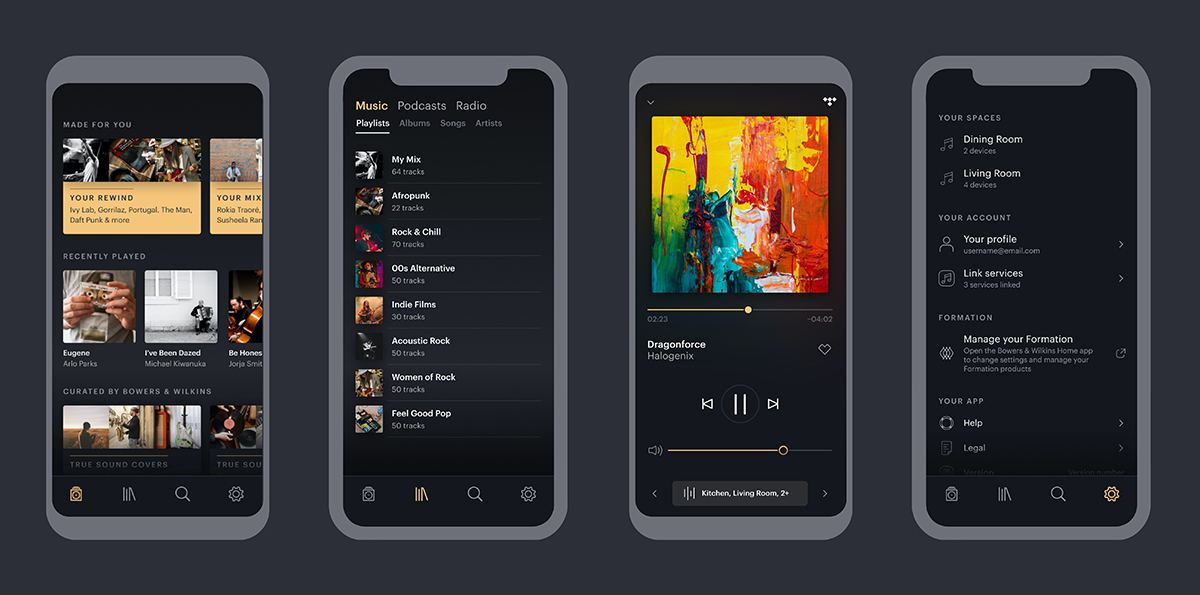
GB: Is the Formation line now filled in? Do you have all the form factors you want to offer? Are a pair of two-way monitors, soundbar, two all-in-ones, a subwoofer, and a streamer everything you want to offer? Do you want to offer different levels of performance?
AK: There’s much more to come. In the first wave, we focused on addressing the majority of use cases. As I mentioned at the outset, our wireless architecture was designed to cope with anything up to 800-series level. We have ongoing plans for more products. I can’t commit to timelines.
We were so pleased with the performance of the wireless technology that as part of our separation from EVA, we acquired the IP [intellectual property]. We want to maintain that technology, and extend it further. The next step will be getting the user interface the way we want, and adding all the streaming services we want. Hopefully from there, we begin expanding into our wave two range of products.
GB: Will Roon remain the only way for people to play music from their digital libraries through Formation products?
AK: We’re still very good friends with Roon, but we’re going to offer other ways of playing locally stored music.
GB: How will the acquisition by Sound United affect Formation? Sound United owns the Denon and Marantz brands, which have their own wireless audio platform—HEOS. How will Formation and HEOS coexist?
AK: The two technologies are parallel, but non-competing in terms of price points and positioning. We are not under pressure from our new friends to do anything to change Formation. They just want us to continue its development and its success; and we’re very grateful for that. We are obviously sharing information. The fact that HEOS has been around for a few years has helped open doors in terms of licensing certain platforms.
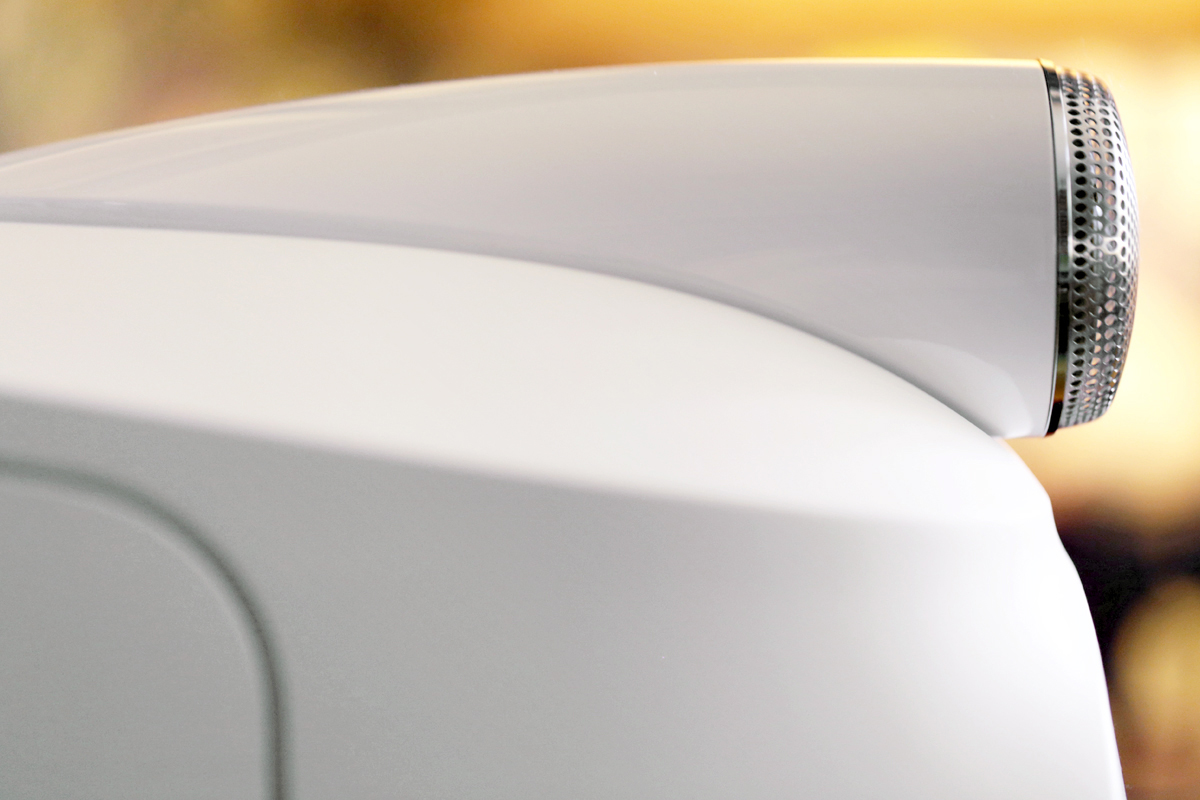
GB: Where do you see home audio going, and where do you see products like Formation fitting in?
AK: I can’t think of a time where more people have had more access to high-resolution audio than today. For all of the concerns we had in the early 2000s about MP3 and the death of sound quality, we have now reached the point where digital doesn’t have to mean dirty. We’re now in an environment that with the right streaming services or the right NAS drive, you have an opportunity to get access to high-quality music far more easily than ever before.
I see a mixed model of listening going forward. There will be people who buy records, like me. There will be people who swear by the CD player. I own thousands of CDs. I haven’t played them in a long time, because I’ve ripped them onto a NAS drive.
Pre-2000, if you saw someone walking down the street wearing a big pair of headphones, they were probably someone working on a building site wearing hearing protection, or a DJ. Even for the first ten years of the iPod, people were still buying $30 or $50 headphones.
Today, it’s much more common to see people wearing premium headphones. Those people are our audience. That audience understands that there is such a thing as a bass line, that there is such a thing as scale, that there is such a thing as dynamic range. That audience will surely want something that delivers a similar experience in their home. We should be able to cater to them.
. . . Gordon Brockhouse
